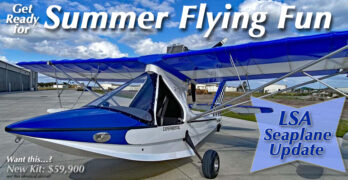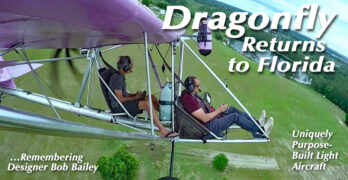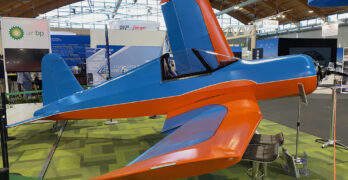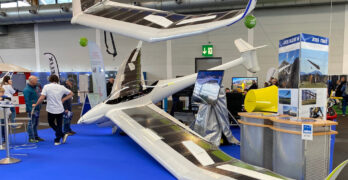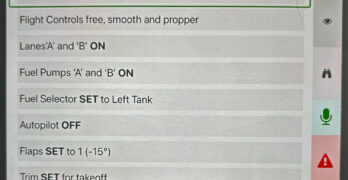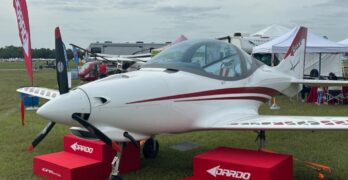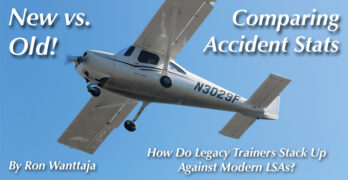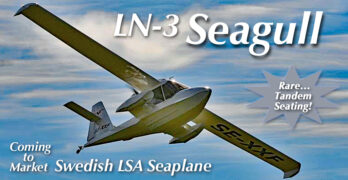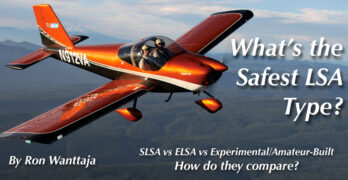One of the most active sectors in light aviation is LSA seaplanes. We’ve seen ups and downs, arrivals and departures of LSA seaplane producers. Admittedly, these flying machines are more complex than current-day LSA. For example, amphibs need retractable landing gear and substantial boat hulls able to take water loads.
LSA seaplanes constitute a highly fluid market yet we can see clues suggesting what might be ahead for some of the main brands. With summertime approaching, this State-of-the-Sector article attempts to keep up with the rapidly changing landscape (or waterscape).
We’ll first look at two high-end entries that have been in the news and conclude with present LSA seaplanes and their status in the market.
Vickers Wave
Writing for AVweb (part of Firecrown, which also owns Flying and ByDanJohnson.com plus several other publications), my fellow aviation journalist Russ Niles stated, “New Zealand-based Vickers Aircraft Company says it intends to make its first delivery of the Wave two-place amphibious aircraft to a U.S.
Search Results for : Flight Design
Not finding exactly what you expected? Try our advanced search option.
Select a manufacturer to go straight to all our content about that manufacturer.
Select an aircraft model to go straight to all our content about that model.
Dragonfly Is Back Home in Florida — Hang Glider Tug … Working Ranch “Tractor”
Dragonfly was born in Florida in the early 1990s. Back-of-the-napkin sketches started in the 1980s following the dynamic 1970s when hang gliding swooped into national awareness. What one designer did with Dragonfly would become one of the most celebrated developments in hang gliding.
Throughout the ’70s, hang glider designs accelerated smartly in glide performance and sink rate, stretching from slope-hugging 4:1 triangular-shaped wings to elegantly long and slender “bladewings” that could exceed a 20:1 glide yet remain foot-launchable and still be an aircraft you could carry on your shoulder (when folded down). Passionate enthusiasts thrilled to a 5X performance improvement in a decade or so.
In the beginning, most pilots launched off mountains to get enough height to catch thermals. Yet lots of America doesn’t have mountainous terrain. Florida had plenty of pilots eager to fly hang gliders but to find the best soaring, they had to load up their gliders and drive 10-12 hours to the hills of Tennessee where flight park operators like me catered to them with mountain launch sites.
AERO Wrapup: Dave Unwin Concludes His Coverage of AERO Friedrichshafen 2024
With my feet failing fast, and the lederhosen beginning to chafe in a most disagreeable fashion, I viewed the end of AERO 2024 with mixed emotions. My legs said enough is enough, but my head, heart and eyes still wanted more—because what a show it was! From replica rocket-powered fighters to jet packs, LSAs fitted with turbines and paramotors for paraplegics and finally to biplane pusher SSDRs, it was a fabulous event.
The AERO team produced a show that they could justifiably be proud of for the 30th anniversary, and although the weather was unseasonably cool, the action in the halls was as hot as ever, and with more than 270 aircraft in the exhibition halls and in the static display, show-goers were not short of mouth-watering machines to tempt their wallets.
Among the aircraft debuting at the show were the electric DA40 aircraft from Diamond Aircraft in Austria, two electric aircraft and a hydrogen powered one from China and the Integral E from French manufacturer Aura Aero.
Day 4 at AERO: A Few More Conventional Aircraft But Also a Few Surprises!
I’ll take the opportunity in this installment to take a look at some of the lighter aircraft to be seen at AERO Friedrichshafen this year.
ICP Ventura 2 and Ventura 4
Italian airframer ICP had several aircraft on display including the Ventura 2 ultralight powered by various permutations of Rotax, and also the Experimental, which as well as being fitted with a Rotax can also be powered by a Lycoming of up to 180 hp. The Venture 2 is a side-by-side two-seater, while the Ventura 4 is, as the name suggests, a four-seater specifically designed to meet the requirements of amateur construction and suitable for the Experimental category. ICP claims that a first time builder can reasonably expect to finish the aircraft in between 700 to 800 hours, while a more experienced builder with practical build experience can complete the aircraft in around 400 hours, excluding paint and upholstery. ICP also had the Savannah SR on show, and this machine bore quite a strong resemblance to the Zenith 701.
Day 3 at AERO: A Look At Sailplanes & Towplanes
The cavernous halls of the Messe truly do contain the aspirations and, let’s be honest, the dreams of literally dozens of designers. There were quite possibly more new types than I have ever seen, and I’ve been attending the Friedrichshafen show for over 20 years. Anyone who claims general aviation is dying would only need to see this show to have their viewpoint radically altered.
Gliding has always been well represented at AERO, and in the show’s 30th year all the major sailplane manufacturers were out in force. For many years AERO was a biennial event and when the organizers made it an annual show, many decided to stick with the biennial schedule and only attend on even-numbered years. There were many different permutations of self-launching and self-sustaining sailplanes on show, which utilized piston engines, electric motors and small jets.
Jonker JS3
South African company Jonker has several versions of the “engine-on-stick” solution for its JS3 single seat high performance sailplane, including an electric motor turning a two-blade propeller and a small jet.
Goose—The Digital Co-Pilot
You can have a co-pilot… even when you can’t get anyone to fly with you! ‘Goose’ is an iOS and Android app which its creators describe as “Alexa for pilots.”
“It’s like having a flight instructor or knowledgeable pilot sitting next to you,” explains Goose’s creator Jeff Bonasso. Introduced a few years ago and formally known as MiraCheck, the app has just been redesigned by AeroSys Technologies. The app works through a series of voice and GPS location activated checklists. For example, tell Goose (through your Bluetooth headset or your phone/tablet mic) that you’re ready for engine start and the app will read the specified list to you, pausing at each step for you to say “Check” before moving on.
You can download previously created checklists or make your own. Once you’re in the air Goose can be set to follow your flight and provide an emergency or pre-landing checklist when asked, or notify you if you deviate from your course or planned altitude.
A First Look at Sun ‘n Fun — LSA, We Got ‘em!
Editor’s Note: Here again let’s take a quick look at some of the LSAs we’ve seen so far at Sun ‘n Fun and welcome Mark Timney to our contributors for this show.
The first-day crowd at Sun ‘n Fun 2024’s Paradise City was a little smaller than usual according to long-time attendees, but what the event’s light sport area might have lacked in numbers it made up for in aircraft evolution.
Of particular note: A sleek, new low wing from Italy’s CFM Aviation that could set the bar for tomorrow’s MLSAs; Magni Gyro’s long awaited M26 Victor; and, a speedy new ultralight flexwing from FlyLight called the ‘Nine. ‘
The hustle and bustle of opening day prevents a detailed report on these aircraft at this time… only an entry-level tease of what Sun ‘n Fun is offering up this year.
The Nine trike, which Great Britain’s Flylight sells through Blue Collar Aviation (BCA) in the US, is distinguished by its 56 mph hands-off cruise speed.
Light Sport Accidents — New LSAs vs. Legacy Trainers
Editor’s Note: This is the second part of Ron Wanttaja’s survey of LSA safety (here’s the first). This time, he takes a close look at how modern LSAs compare with legacy trainers as epitomized by Cessna’s 152, both in terms of accident rates and the kinds of mayhem they succumb to. Let’s dive in!
In the previous safety review, we looked various forms of LSA—SLSA, ELSA and Experimental/Amateur-Built. For this article, we’ll look only at SLSA airplanes. We’re not addressing powered parachutes, weight shift or other SLSA classes—just traditional flying machines with wings and a motor. Call them “SLSA-A,” or “SLSA-As” for plural. We’ll address their accidents from 2005 through 2021.
To identify the SLSA-A accidents, I cross-referenced the NTSB accident database with FAA registrations, including both active and inactive aircraft.
What to compare them to? Let’s pick the near-ubiquitous Cessna 152. It’s close to the general definition of Light Sport, other than exceeding the LSA gross weight requirement.
Swedish LN-3 Seagull — Tandem-Seating LSA Seaplane …Plus, Breaking News!
LSA seaplanes are a segment all to themselves. [See Breaking News at bottom!]
It isn’t only that seaplanes can offer “triphibian” capabilities (a term once promoted by MVP) because they can operate from land, water, or snow. That makes them versatile but amphibious craft must incorporate retractable gear and since they require a sturdy hydrodynamic boat hull as well as aerodynamic aircraft structures, the engineering task becomes significantly larger than land plane designs.
Icon took years with their A5 and Vickers is still working on their Wave. Both took more than a decade to reach market. Several other LSA seaplane projects required similarly lengthy development.
Now from Svenska Flygfabriken (Swedish Aviation Factory) comes LN-3. This new entry is distinctive because it is a tandem-seating seaplane. Yes, I know lots of Cub-types on floats are tandem but among boat-hulled seaplanes, I’m not aware of any others like this.
Light Sport Accidents — How Do The Categories Compare?
Editor’s Note: This two-part short series is the handiwork of Ron Wanttaja, who has been tracking accident and registration data for Experimental aircraft for decades. Here, he looks at both the fleet size and accident rates among the various LSA categories. Looking ahead, the next installment will dig deep into how LSAs fare against more common certified trainers.
It’s been almost 20 years since the FAA implemented the Light Sport Aircraft category. While the planes might appear similar to traditional Experimental/Amateur-Built (E/A-B) aircraft, there are significant differences in how they are designed, constructed, maintained and operated.
Light Sports have had a major impact on flying in the U.S., even if their numbers are still relatively few. Without Light Sport (and the accompanying Sport Pilot program), the FAA would have lacked data to justify the simplification of pilot medicals known as BasicMed. Light Sport’s proven safety led to the MOSAIC program, featuring a major relaxation of the limits of what can be flown without an FAA medical.
- « Previous Page
- 1
- …
- 45
- 46
- 47
- 48
- 49
- …
- 147
- Next Page »


